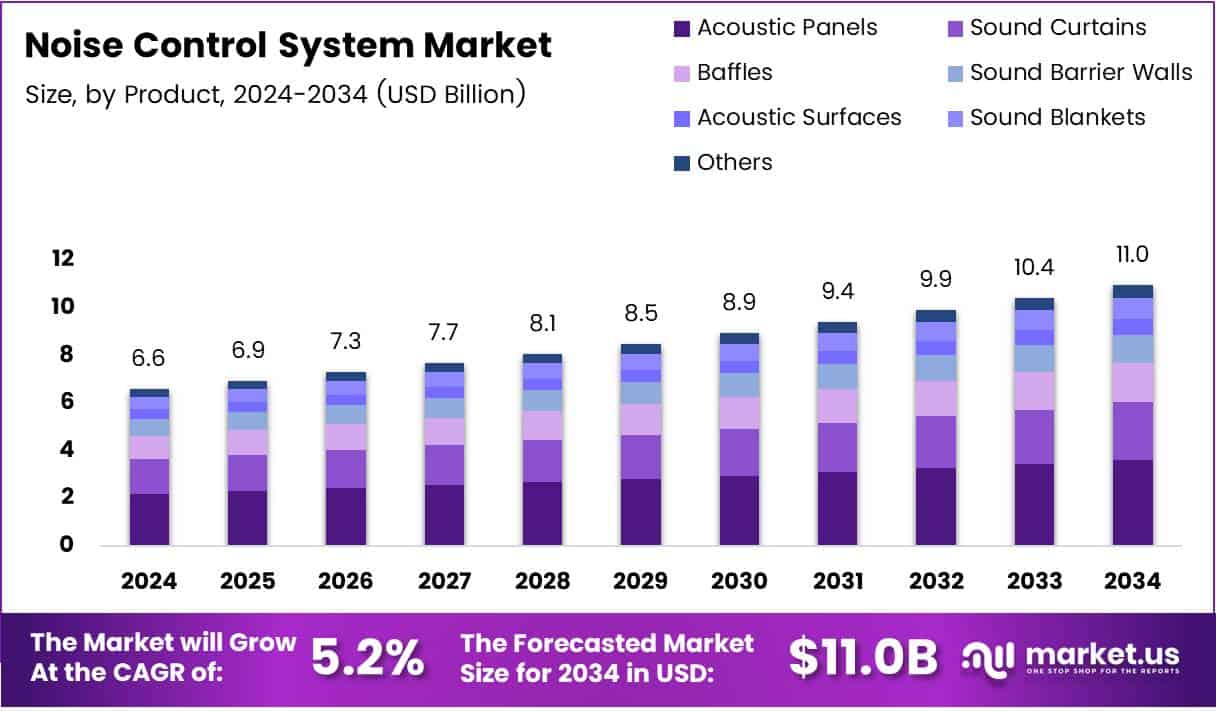Table of Contents
The global Noise Control System Market is projected to grow from USD 6.6 billion in 2024 to USD 11.0 billion by 2034, achieving a compound annual growth rate (CAGR) of 5.2% during the forecast period.
Market Overview
The Noise Control System Market is experiencing significant growth, driven by the increasing need for noise reduction in various industries. With stricter regulations and the growing awareness of noise pollution’s harmful effects, the demand for innovative solutions such as advanced acoustic materials and noise barriers is on the rise. For instance, sinay reports that noise emission monitoring can reduce noise levels by up to 20% in busy shipping lanes, mitigating environmental impact.

Opportunities abound in sectors like construction, automotive, and data centers, where noise control is becoming a priority. Technological advancements in noise-reduction materials are paving the way for more effective solutions. As noted by wolfspeed, silicon carbide-based cooling systems are reducing data center noise by enhancing efficiency, achieving 50% reduction in system losses, and contributing to global efficiency standards while lowering audible noise.
Governments across the globe are increasingly investing in noise control solutions to protect public health and the environment. Regulations are becoming stricter, with cities and industries adopting mandatory noise reduction policies. For example, decibel suggests that thick curtains can reduce noise by up to 7 decibels, while materials like floating floors can cut impact noise by up to 75%, further emphasizing the need for comprehensive noise control systems.
Product Segmentation
The noise control system market comprises several product types, each serving specific applications:
- Acoustic Panels: Leading the market with a 23.3% share in 2024, acoustic panels are favored for their effective sound absorption and aesthetic appeal. They are commonly used in offices, theaters, and educational institutions.
- Sound Curtains: These are utilized to block noise transmission between spaces, often in industrial settings.
- Baffles: Suspended from ceilings, baffles help in controlling sound reflections and are typically used in large open spaces.
- Sound Barrier Walls: Employed in outdoor environments, these walls reduce noise pollution from highways and railways.
- Acoustic Surfaces and Tiles: Used to enhance the acoustics of a room by reducing sound reflections.
- Sound Blankets and Insulating Flooring: These products are designed to dampen noise transmission in both residential and commercial buildings.
- Sound Doors: Specialized doors that provide sound insulation, commonly used in recording studios and conference rooms.
Application Areas
Noise control systems are applied across various sectors:
- Commercial: Accounting for 37.3% of the market share in 2024, this segment includes offices, hotels, and malls, where a quiet environment is essential for productivity and customer satisfaction.
- Industrial: Manufacturing plants and factories require noise control solutions to comply with occupational health and safety regulations and to protect workers’ hearing.
- Residential: With increasing urbanization, there is a growing need for noise control in residential areas to ensure a peaceful living environment.
Regional Insights
- North America: Leading the market with a 37.8% share in 2024, North America benefits from stringent noise regulations and significant investments in infrastructure development.
- Asia-Pacific: Emerging economies in this region, particularly India, China, and Southeast Asia, are experiencing rapid industrialization, leading to a surge in demand for noise control systems.
- Europe: Countries in Europe are implementing strict environmental standards, driving the adoption of noise control solutions in various sectors.
Market Trends
- Integration of Smart Technologies: There is a growing trend towards integrating smart technologies in noise control systems, such as sensors and automated controls, to enhance efficiency and user experience.
- Sustainable Materials: The use of eco-friendly and sustainable materials in the manufacturing of noise control products is gaining traction, aligning with global sustainability goals.
- Customization: Tailored solutions that meet specific acoustic requirements of different environments are becoming increasingly popular.
Challenges
- High Initial Costs: The installation of advanced noise control systems can involve significant upfront investment, which may deter some potential customers.
- Maintenance: Regular maintenance is essential to ensure the effectiveness of noise control systems, which can incur additional costs.
- Awareness: In some regions, there is a lack of awareness about the benefits of noise control systems, hindering market growth.
Recent Developments
- In Jan 2025, with €6.3 million in funding from the European Union, the 15 project partners are focusing on developing innovative noise reduction technologies, establishing regulatory standards, and advancing industry practices to protect marine habitats from harmful noise pollution.
- In Apr 2025, FasterCapital has supported over 734 startups in raising more than $2.2 billion, while directly investing over $696 million in 288 companies, further solidifying its role as a key player in the startup ecosystem.
- In Mar 2024, Catalyst Acoustics Group completed the acquisition of RealAcoustix, strengthening its portfolio and expanding its capabilities in the field of noise control and acoustics solutions.
- In May 2025, Catalyst Acoustics Group announced that it completed the acquisition of Curb Technologies, enhancing its technological offerings and market presence in the noise control and environmental sound management sectors.
Conclusion
The Noise Control System Market is poised for substantial growth, driven by increasing noise pollution concerns, stringent regulations, and technological advancements. Stakeholders in various sectors must recognize the importance of investing in effective noise control solutions to enhance acoustic comfort and comply with regulatory standards.
Discuss your needs with our analyst
Please share your requirements with more details so our analyst can check if they can solve your problem(s)



